

Aerial Photos Are New Weapon In Organic Civil War. The Cornucopia Institute commissioned this photo of an organic egg producer in Saranac, Mich.

According to Cornucopia, the facility is owned by Herbruck's Poultry Ranch, which has a license to maintain up to 1 million chickens on this site. Courtesy of The Cornucopia Institute hide caption itoggle caption Courtesy of The Cornucopia Institute. What’s So Bad About Gluten? Just after Labor Day, the Gluten and Allergen Free Expo stopped for a weekend at the Meadowlands Exposition Center.
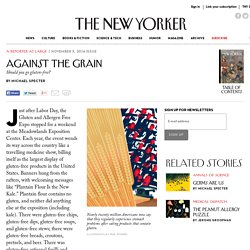
Each year, the event wends its way across the country like a travelling medicine show, billing itself as the largest display of gluten-free products in the United States. Banners hung from the rafters, with welcoming messages like “Plantain Flour Is the New Kale.” Plantain flour contains no gluten, and neither did anything else at the exposition (including kale).
There were gluten-free chips, gluten-free dips, gluten-free soups, and gluten-free stews; there were gluten-free breads, croutons, pretzels, and beer. There was gluten-free artisanal fusilli and penne from Italy, and gluten-free artisanal fusilli and penne from the United States. Gluten, one of the most heavily consumed proteins on earth, is created when two molecules, glutenin and gliadin, come into contact and form a bond. Wheat is easy to grow, to store, and to ship. Donald Kasarda, a researcher at the U.S. Hartbeat newsletter. Mort de Visez santé. «Ce n'est pas une mauvaise chose, a commenté Alexandra Leduc, diététiste et présidente de Makéa nutrition.

Ce programme était désuet. Certains aliments avaient ce logo alors qu'ils n'auraient pas dû l'avoir. Restos français: un logo «fait maison» pour endiguer les arnaques. Des légumes moches, bons, pas chers. «Une carotte moche, c'est une jolie soupe» ou encore «La pomme de terre moche, élue Miss purée 2013», lit-on sur les publicités de la chaîne française d'épiceries Intermarché.
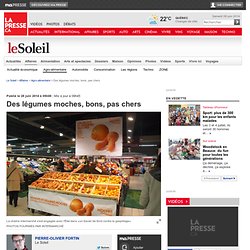
La campagne humoristique et percutante sur Internet est virale, elle a même remporté un prix de publicité. Et l'initiative, bien que modeste, a aussi connu un succès boeuf. What Exactly Defines a “Craft” Spirit? We Are What We Eat - Gastronomica. The Origins and Current Legal Status of “Natural” and “Organic” Food Labels The cook plays an important part in the nourishability of food.
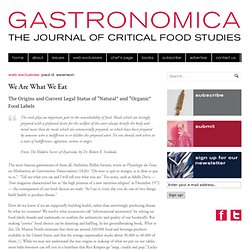
Meals which are lovingly prepared with a profound desire for the welfare of the eater always benefit the body and mind more than do meals which are commercially prepared, or which have been prepared by someone who is indifferent to or dislikes the proposed eater. Canada's rules for organic food - Canada. It has been two and a half years since Canada set out new federal regulations governing the production and sale of organic products.
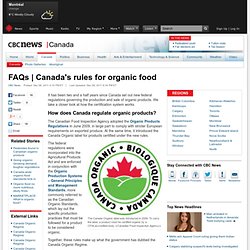
We take a closer look at how the certification system works. How does Canada regulate organic products? The Canadian Food Inspection Agency adopted the Organic Products Regulations in June 2009, in large part to comply with stricter European requirements on exported produce. At the same time, it introduced the Canada Organic label for products certified under the new rules. Organic becoming the latest marketing gimmick - Business.
I was in the grocery store stocking up on supplies for a hot dog dinner with my daughter.

Perusing the condiment isle, something caught my eye: a slick label and the word "organic" emblazoned on one of those upside-down plastic squeeze ketchup bottles. I laughed. Now this is rich. I compared prices, amid the myriad varieties of mustard and mayo. Seven hundred and fifty milliliters of organic ketchup cost almost $7.
Pesticide residue found on nearly half of organic produce - Manitoba. Nearly half the organic fresh fruits and vegetables tested across Canada in the past two years contained pesticide residue, according to a CBC News analysis of data supplied by the Canadian Food Inspection Agency (CFIA).

Of the 45.8 per cent of samples that tested positive for some trace of pesticide, a smaller amount — 1.8 per cent — violated Canada’s maximum allowable limits for the presence of pesticides, the data shows. Mathieu Rey, an organic food consumer in Winnipeg, says he did not expect to hear that the produce he buys may contain pesticides. (CBC) The data released to CBC News under the federal Access to Information Act includes testing of organic fruits and vegetables sampled between September 2011 and September 2013.
B.C. bakery caught selling mislabelled 'organic' bread - Canada. A bakery in Burnaby, B.C., was caught knowingly selling organic bread that was not actually organic, yet the Canadian Food Inspection Agency did not charge the bakery for misleading customers.

CBC News obtained nearly 200 documents in an access to information request regarding an investigation into Mediterranean Bakery. The bakery produces organic bread for local restaurants and specialty stores such as Bosa Food and Whole Foods. New Ways of Working and Organization: Alternative Agrifood Movements and Agrifood Researchers. De nouvelles traditions classées au patrimoine immatériel par l'UNESCO. «Le washoku est un ensemble très riche de savoir-faire, de connaissances et de traditions liés à la préparation et à la consommation d'aliments, et au respect des ressources naturelles, observé typiquement lors des fêtes du Nouvel An», a précisé l'Organisation des Nations unies pour l'éducation, la science et la culture (UNESCO) dans un communiqué.
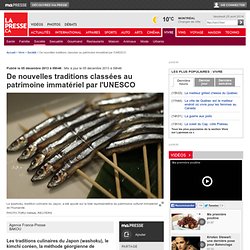
«Je me sens vraiment heureux», a réagi le premier ministre japonais, Shinzo Abe, dans un communiqué. Dynasimple. La SAQ veut créer son logo «bio» The Organic "Health Halo" Effect. Japon: de grands restaurants passent à table après avoir enjolivé leurs menus. Le scandale prend chaque jour un peu plus d'ampleur depuis que le groupe d'hôtellerie Hankyu Hanshin d'Osaka a reconnu en octobre de telles tromperies sur la marchandise.
Le patron a démissionné après que 23 restaurants et salles de banquet de 8 hôtels du groupe ont avoué des «erreurs» de dénomination concernant 47 produits. Il s'agissait le plus souvent d'afficher un ingrédient de luxe tout en cuisinant avec une denrée bon marché. Depuis, tous les groupes se mettent à table. Reading the Real: An Illustrated Tour of Montreal’s Marché Jean-Talon. The slogan of Montreal’s Marché Jean-Talon is “When country comes to town.” An afternoon stroll through the city’s largest public food market suggests that the word “country” applies in two senses: country, as in the rural landscape, and country, as in one of the nations of the world. It thus constitutes a suitable microcosm for the exploration of larger issues related to consumer trends towards provenance purchasing and the promotion of place as the primary marker of alimentary authenticity in the wider food marketplace.
Neige et Citrouille: Marché Atwater and Seasonality. Introduction An urban farmers’ market is more than a place to buy food. Markets act as a meeting place and as a town square, reinforcing both community and regional identity. Markets have historically retained importance as what Manuel Castells names a “space of flows,”[1] where the daily meeting of culture and nature—that is, the food system—inscribes itself upon the city. The market square and the market hall serve as a centre of the city, a critical infrastructure that allows the coming together of many people. Markets can thus reveal important aspects of urban culture. Élevage: de la ferme à la maison. Le propriétaire de la ferme Boeuf Nature livre sa viande de boeuf, de veau ou de porc directement au domicile de ses clients, une fois aux deux ou trois semaines. U.S. Department of Agriculture guts national organic law. September 19, 2013 Joint statement of Consumers Union, Food and Water Watch, Beyond Pesticides and Center for Food Safety U.S.
Department of Agriculture Guts National Organic Law; Circumvents Public Process. Le Québec, plus grand consommateur d'aliments locaux au pays. Les aliments locaux sont plus populaires au Québec et en Ontario selon un récent rapport. Intitulé Cultivons les bonnes affaires: L'appétit grandissant du Canada pour les aliments locaux, ce rapport du Conference Board du Canada indique aussi que c'est dans ces deux provinces que les systèmes alimentaires locaux ont le plus d’impact positifs sur l'économie.
Le Québec arrive ainsi au premier rang avec 29% de sa production alimentaire globale consommée par les Québécois et l'Ontario suit derrière avec 24% de ces produits alimentaires locaux consommés localement. Au Canada, c'est 20% des aliments qui sont consommés dans la province où ils sont produits. Les aliments locaux constituent aussi une part importante des aliments consommés en Colombie-Britannique avec 16% et en Nouvelle-Écosse, avec 13%. Parmi les autres faits saillants du rapport : Pour en savoir plus, cliquez ici. Certified Naturally Grown: An alternative label to organic. Workers transplant lettuce in a field at Denison Farm on Monday, Aug. 12, 2013, in Schaghticoke, N.Y.
Participants in the Certified Naturally Grown program must adhere to organic principles such as avoiding synthetic chemicals. Proponents say the program lets them promote their commitment to sustainable agriculture without the cost and extensive paperwork of the USDA program.Associated Press SCHAGHTICOKE, N.Y. (AP) -- Justine and Brian Denison say they adhere to all the growing practices required for organic certification, yet if they label their beans and tomatoes "organic" at the farmer's market, they could face federal charges and $20,000 or more in fines. Because the Denisons chose not to seek organic certification by the U.S. Une carotte à la fois.
J’ai fait un peu exprès pour me perdre dans ce coin de pays où j’ai laissé filer mon enfance à l’ombre du mont Pinacle. C’était là, Les Jardins de la Grelinette, cachés sur le chemin Guthrie, une fermette comme on n’en croise plus tellement après des kilomètres de champs de maïs sous un soleil de plomb. Embodied Food Politics by Michael S. Carolan - Reviews, Discussion, Bookclubs, Lists.